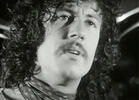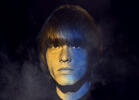
Twenty-nine years ago (April 5, 1994), Kurt Cobain allegedly committed suicide. His body was found on April 8. High on heroin, many have wondered how Cobain could have fired a shotgun. A 2014 investigation by Seattle PD confirmed their original suicide conclusion.
A private-eye, Tom Grant, hired by Cobain's wife Courtney Love; a singer with the Mentors, El Duce; and Love's own father, Hank Harrison, all have contended that Cobain didn't kill himself.
Nick Broomfield's 1998 doc Kurt & Courtney covers some of this territory.
A movie about the P.I., Tom Grant, Soaked in Bleach, was released in 2014. Watch the trailer below.
Ian Halperin and Max Wallace have teamed up on two books about the subject, the aptly titled Who Killed Kurt Cobain: The Mysterious Death of an Icon in 2000 and Love and Death: The Murder of Kurt Cobain in 2005.

On May 8, 2021, the FBI released 10 pages of documents related to inquiries about Cobain's death. In a letter sent to the Seattle FBI office, dated Sept. 24, 2003, the redacted writer says, "A great injustice may have been committed in the case of Kurt Cobain... The official story from the Seattle police department is that he took his own life. However, there are a lot of unanswered questions and inconsistencies with this... I feel information has been ignored and suppressed long enough by the Seattle police and the media. I'm writing you in hopes for your help to press for a reexamimation of Mr. Cobain's death."
A second letter, this one sent to J. Edgar Hoover by a woman from Philadelphia on Nov. 20. 2006, is a two-page missive. "The police who took up this case were never very serious about investigating it as a murder," the redacted writer explains. "There is more than enough evidence to reopen the case and change the cause of death from suicide to murder."
Linda M. Trigeiro-Pabst from the FBI's executive secretariat office replied with a letter on Feb. 7, 2007:
"We appreciate your concern the Mr. Cobain may have been a victim of a homicide. However, most homicide investigations generally fall within the jurisdiction of state and local authorities. In order for the FBI to initiatiate an investigation of any complaint we receive, specific facts must be present to indicate that a violation of a federal law within our investigative jurisdiction has occurred. Based on the information you provided, we are unable to identiify any violation of federal law within the investigative jurisdiction of the FBI. We are, therefore, unable to take any investigative action in this case."
The Original "Who Killed Kurt?" Article

In 1996, when I was music editor of High Times, I launched an investigation into the death of Kurt Cobain, who'd died two years earlier. This was the result of contact made with several people who had information that contradicted the official police conclusion that Cobain killed himself with a rifle.
The first was Tom Grant, the P.I. Courtney Love hired him to find her husband who'd gone AWOL from a rehab center. Grant told me that Love was not honest with her. Ultimately, he concluded that she must have played some role in Cobain's death.
The second was El Duce (nee Eldon Hoke), leader of L.A. punk-rock band the Mentors, who claimed Love offered him $50,000 to kill Cobain. This account was verified by a record store owner who knew El Duce. Like all conspiracy stories, there are usually several dead bodies. El Duce's was found on railroad tracks in San Bernardino a year after the HIgh TImes article was published.
The third was Hank Harrison, Love's father and a former contributor to High Times, who agreed with the theory that Love had something to so with Cobain's death. The father and daughter were not on speaking terms then and after Harrison's comments in High Times and his 2017 book Love Kills: The Assassination of Kurt Cobain, certainly never again. Essentially, Harrison believes Love was capable of anything, even orchestrating her huband's death.
Why would Love do that? For the money? She would control the Nirvana estate. Though it does seem far-fetched, I kept thinking "what if?" as I continued to research and edit the article. (I had two co-writers: Tim Kenneally and Victor Bockris.)
Bockris seized on the fourth angle, perhaps the most ludicous and yet most plausible evidence of all. A fax was sent to High Times regarding Cobain's use of a trippy, rudimentary device known as the Dream Machine. William S. Burroughs, who Cobain admired, popularized it in the '50s and by the '90s it was coming back into vogue. Cobain bought one and allegedly stared at its strobe-lighting effects until he went over the edge. We later learned that Love had someone send the fax. If true, Love was trying to build a case that it was the Dream Machine that did it (and Cobain's addiction to heroin, which Burroughs also popularized in books like Junky and Naked Lunch). So blame Burroughs. goes this theory.
I quietly cobbled together the complicated conspiracy story. The article was supposed to appear in the music section and not as a feature, but when editor Steve Hager read it, he bumped it up to a feature and cover story. It's the only conspiracy story I've ever written.
After the issue came out, Love's lawyers sent High Times a cease and desist order. The company ignored it.
From that point on, writers and movie directors have pawed away at this story, hoping to open a new door with revealing information.
Why the FBI released the Cobain letters is unclear, other than they occasionally release documents from their archives. All it does is stir up old, unresolved theories.
What do you think? Did Cobain commit suicide or was he murdered?
This article was originally posted on Apr. 29, 2014.






